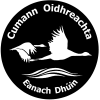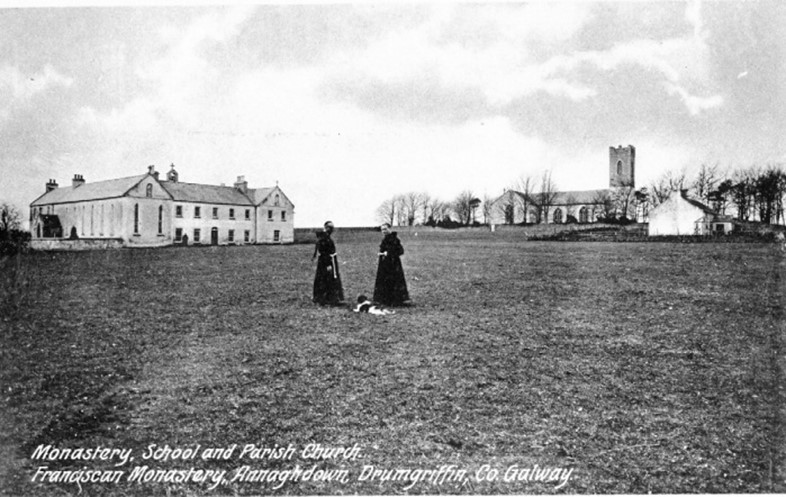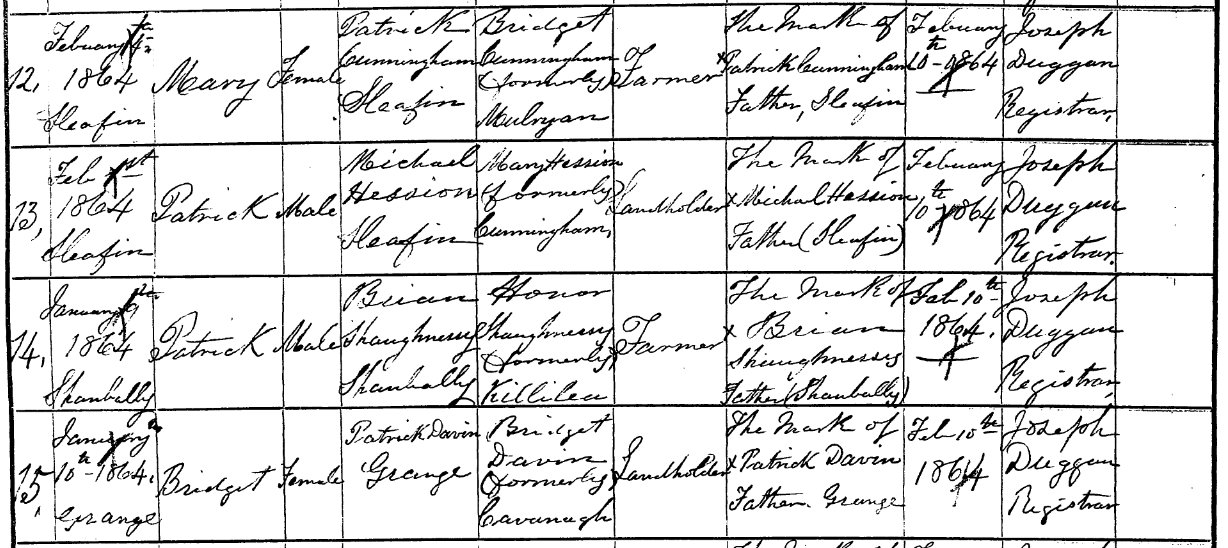By Mary Forde (née Goaley), 1925-2018.
This article describes the destruction of Annaghdown Church by fire in 1936 and subsequent reconstruction work. It first appeared in Anach Cuain 2004.
It was on Tuesday night, 1st December 1936 as we were going to bed about 9 o’clock. My father and mother had gone to put some of their children to bed as some of us had measles at the time. As he looked out the window my father saw flames. He enquired if Micil Fahy had a cock of hay in his field as he usually kept a sheep cock in the field at the foot of the hill between the Church and the school (the old school).
We all rushed to the windows to see the flames, that is all who hadn’t measles and in our childish innocence we were secretly hoping that the school was on fire. We would have enforced holidays! We were ordered to bed but my parents had their suspicions as they gauged the size of the flames but kept their thoughts to themselves at the time. Later they went downstairs and went outside to have a better look. They could hear the burning beams fall on the floor and knew the echo from the church floor.
At the time communism had been raising its head in Europe and some recruiting had been in progress in Ireland. As it was the time of the Franco war in Spain, some volunteers called Blue Shirts had gone from Ireland to support Franco. Any damage done against the Catholic church was treated with suspicion. Therefore this incident was that of the Communists or so people thought.
My father got on his bicycle straight away and as he was going out the gate two neighbours passed by. One had a gun and shouted “whoever is there now we are ready for them”. That should explain their suspicions. At that time there were only two telephones in the parish; the post office and the garda barracks. The post office was confined to office hours and the barracks was availed of outside of office hours. But to return to the church… it was a custom of that time that nobody passed the church without going in to say a prayer except a man leading a horse and cart. The only lighting inside was that of the sanctuary lamp or that of the candelabra. Everybody put in a few pence to keep the candles lighting. It was a penny a candle.
Fr. Colgan was curate at Annaghdown and Fr. McGough was parish priest at Corrandulla. Kathleen O’Flynn used to bring milk to the priest at night-time and the Kavanaghs every morning. As Kathleen used to do her church visiting in the evening she took the job on in the evening while the Kavanaghs brought it on their way to school in the mornings. Sometimes Fr. Colgan would invite Kathleen in for a chat, a thing he had done on the night in question. At about 9.20pm a passer-by, Pat Duggan, on his way home from a game of cards noticed the fire in the sacristy. He called in to tell Fr. Colgan who invited him in for a chat but all that changed when he told him that he noticed something burning in the sacristy. Pat Duggan returned immediately to Kavanagh’s for help as he knew that the card players were still there. His Baby Ford was well loaded with men and buckets etc. Kathleen O’Flynn went down to Blake’s. Harry and Walter Blake were there with two male visitors but it was too late. In the meantime Fr. Colgan tried to save the Blessed Sacrament in the tabernacle but couldn’t pass the altar rails as the heat from the sacristy was too intense. He said if he had only a man with a hatchet to break the door as it was wooden – something that changed all over after that – he might have succeeded. The key of the tabernacle was in the safe. The key of the safe was in the press and the press was burned. The helpers started to bring out the seats and had to abandon when the roof beams fell beside them. As there were too many obstructing each other, Martin Kavanagh decided to go to the side-door and on the way thought about the organ and returned for a helper. When they got there the flames came out the door against them and hit the garden wall so they had to abandon it. In all, there were only fifteen seats saved.
In the meantime a messenger was sent to Fr. McGough and he rang for the fire brigade from the barracks and then went to Annaghdown himself. He said that when he turned Blake’s corner the sight that met his eyes he would never forget. The fire brigade returned the call with a request that they’d have a guarantee from the parish to get paid – a matter that caused a lot of controversy later on and were forced to change that rule in future (Nero fiddled while Rome burned). Sergeant Fox had to come back on his bicycle to Annaghdown to Fr. McGough and he in turn had to go to the barracks and give the guarantee. In all that time the church was burning with only buckets and two small tanks for water. The fire brigade only arrived to dampen down the ashes. A chalice and ciborium in the safe were saved.
The cause of the fire was never established but there was only one explanation. There was a corpse in the church the night before; a Mulryan from Addergoole as far as I know. The thurible being used at the blessing of the coffin may have a burning fragment of charcoal in it as it hung on the wall with the vestments. The Mass servers of the day said they took it outside to empty it as usual. It did remain a mystery.
The insurance cover at the time was £1,000 so there was a full reconstruction fund set up. To get a contractor to take the risk was underway as soon as it had reached £2,000. The first man to take on the job was the late Archbishop Cunnane’s father and I remember seeing him checking the timber coming off the lorry on our way from school. He had a black pin-stripe suit and black hat. Owing to ill-health he had to abandon it and Mark Heneghan from Tuam took it on. His man in charge of roofing was John Henihan from Athenry Road, Tuam (the historian). He stayed with his sister Mrs. Stanton in Annaghdown, going home on a bicycle at weekends. There was another qualified carpenter Paddy Donoghue from Belclare and two apprentices, Bill Mahon from Clough, Cummer and Michael McTigue from Belclare. They remained on to the end. Slaters and plasterers came on as they were needed and Mr. Rock from Dublin did the marble work on the altar.
In the meantime we had mass in the school and on Friday evenings we had to prepare the school for Sunday mass. We had to arrange the school seats and the 15 church seats to face the altar at the back of the schoolroom. On Monday morning we had to re-arrange all those and close in the church seats as far as possible.
The first Mass was read in the reconstructed church on St. Patrick’s Day 1938 with the 15 salvaged seats to start off with until the seating was supplied later on. I think Tommy Kavanagh was the first child baptised in the church after reconstruction.
Further Reading
- Martin Newell: The Church of St Brendan by the Lake, Annaghdown, 1903-2003 – text of the commemorative booklet produced for the centenary.
- Martin Newell: Centenary Celebrations at the Church of St Brendan By the Lake, Annaghdown, published in Anach Cuain 2003.
- Martin Newell: Nobis Ministerium Reconciliationis (Ours is the Ministry of Reconciliation) – Reflections on Archbishop Courtney’s Visit, written following his assassination in December 2003; published in Anach Cuain 2006.




Interesting article about the church fire in Annaghdown. I have news report from the Galway newspaper. It was sent to my grandfather, Bartholomew (Michael/Mary Flynn Kavanagh), here in the USA. I sent a copy to Paul G. after I met him back in 2015. Also left a copy on the table in the church when I visited with my cousin Briga O’Connell.
When you see Paul, tell him I am returning in 2020 so I may have time to see him.
Bernard Kavanagh
Hi Bernard, Paul here – Good to hear from you. Hope to see you in 2020.